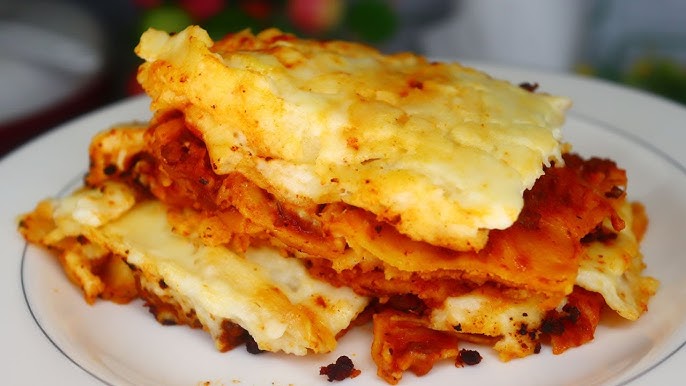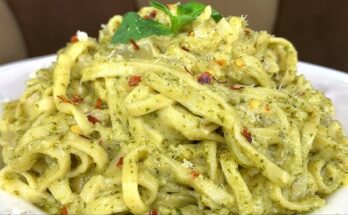Barilla Lasagna Recipe: Lasagna is one of those timeless dishes that warms the heart and fills the stomach with comfort and joy. And when it comes to creating a truly memorable lasagna, using Barilla lasagna noodles makes all the difference.
This step-by-step guide will walk you through everything you need to make a mouthwatering, perfectly layered Barilla lasagna that your family and friends will rave about.
Why Choose Barilla Lasagna?
Barilla is a name that’s become synonymous with quality pasta. Their lasagna noodles are no exception. Whether you’re a seasoned chef or a home cook experimenting in the kitchen, Barilla provides a consistent and premium product that ensures great results every time. What sets Barilla apart is the quality of the durum wheat they use, resulting in a firm, golden noodle that holds up well under layers of rich sauce and gooey cheese.
Choosing Barilla means choosing reliability. These noodles cook evenly and don’t get mushy or break apart, which is a common problem with lesser brands. With Barilla, you’ll get that perfect “al dente” texture every single time. It’s ideal for making a classic Italian-style lasagna or even experimenting with vegetarian or white sauce versions. The versatility and quality make Barilla a must-have for any serious home cook.
Perfect for Family Dinners and Special Occasions
Lasagna is more than just a meal—it’s an event. Whether it’s a cozy Sunday family dinner, a potluck with friends, or a holiday celebration, lasagna is a dish that brings people together. Barilla lasagna, with its robust texture and traditional Italian craftsmanship, is designed to elevate these special moments. One tray feeds a crowd, and leftovers are always a hit the next day.
What’s great about this recipe is how adaptable it is. Want to add more cheese? Go for it. Prefer ground turkey over beef? Swap it out. Need to make it vegetarian? Replace the meat sauce with roasted veggies. This flexibility means you can tailor the recipe to suit any occasion or dietary preference.
Ingredients You’ll Need
Barilla Lasagna Noodles
At the core of this recipe are the noodles. You can opt for Barilla’s traditional lasagna noodles, which require boiling, or their oven-ready no-boil version, which can save a step without sacrificing quality. Either choice delivers a rich, chewy bite that serves as the perfect vehicle for the sauces and cheeses.
You’ll need:
- 1 box Barilla Lasagna (Regular or Oven-Ready)
Meat Sauce Components
The heart of any classic lasagna is a rich, savory meat sauce. We’re talking about a thick, slow-simmered ragu-style sauce that seeps into every layer, bringing depth and bold flavor to the dish.
Ingredients include:
- 1 lb ground beef (or a mix of beef and pork)
- 1 small onion, diced
- 3 cloves garlic, minced
- 1 (28 oz) can crushed tomatoes
- 1 (6 oz) can tomato paste
- 1 tsp salt
- 1 tsp sugar
- 1/2 tsp black pepper
- 1 tsp dried oregano
- 1 tsp dried basil
- 2 tbsp olive oil
Cheese Blend Essentials
Lasagna isn’t complete without a generous layer of creamy, melty cheese. This recipe uses a classic three-cheese blend to achieve that iconic cheesy goodness.
You’ll need:
- 15 oz ricotta cheese
- 2 cups shredded mozzarella cheese
- 1/2 cup grated Parmesan cheese
- 1 egg (to mix with ricotta for binding)
- Salt and pepper to taste
Optional Add-ins for Extra Flavor
Want to jazz up your lasagna a bit? Here are a few optional ingredients that can add a gourmet touch:
- Fresh spinach (for added greens)
- Sliced mushrooms (sautéed)
- Red pepper flakes (for a little kick)
- Fresh basil (for garnish)
- Bechamel sauce (for a richer texture)
Preparing the Meat Sauce
Browning the Meat
Start by heating olive oil in a large skillet over medium-high heat. Add the diced onion and garlic, sautéing until fragrant and translucent. This step alone sets the foundation for flavor—don’t rush it.
Next, add your ground meat. Cook it thoroughly, breaking it apart with a wooden spoon to ensure even browning. Drain any excess fat to avoid a greasy sauce. This step takes about 6–8 minutes, and it’s crucial for building a hearty, rich sauce that won’t make your lasagna soggy.
Building the Flavor with Tomato Sauce and Herbs
Once the meat is browned, stir in the crushed tomatoes and tomato paste. Add your spices—oregano, basil, salt, pepper, and sugar—to balance the acidity of the tomatoes. Reduce the heat to low and let this mixture simmer for at least 20–30 minutes.
This slow simmer not only thickens the sauce but allows the flavors to develop and meld together. Some folks add a splash of red wine or a touch of heavy cream to deepen the flavor—feel free to get creative. At the end, your kitchen will be filled with the irresistible aroma of Italian comfort food at its best.
Cooking the Barilla Lasagna Noodles
How to Boil Perfect Lasagna Noodles
If you’re using the traditional Barilla noodles, bring a large pot of salted water to a rolling boil. Drop the noodles in a few at a time and cook according to the package instructions, usually around 8–10 minutes.
Here are some tips for perfect noodles:
- Stir occasionally to prevent sticking.
- Don’t overcook them—they’ll continue cooking in the oven.
- Drain and lay them flat on a towel to avoid clumping.
Alternative: No-Boil Option Explained
If you’re short on time or want a simpler process, Barilla’s oven-ready lasagna noodles are a game-changer. These noodles cook right in the pan, absorbing moisture from the sauce and cheese to become perfectly tender.
The key here is moisture—make sure your sauce isn’t too dry. Adding a bit more tomato sauce or even a few spoonfuls of water to each layer ensures the noodles cook evenly and remain soft.
Assembling the Lasagna
Layering Techniques
Here’s where the magic truly begins. Assembling a lasagna is like creating a savory layered cake—each layer builds upon the last, culminating in a masterpiece of texture and flavor. Start by preheating your oven to 375°F (190°C) and grabbing a 9×13 inch baking dish. Grease it lightly with olive oil or non-stick spray to prevent sticking.
Start with a generous spoonful of your meat sauce spread evenly on the bottom of the dish. This prevents the noodles from sticking and infuses the base with flavor. Next, lay down your first layer of Barilla noodles. If you’re using oven-ready noodles, be sure to slightly overlap them. If using boiled noodles, make sure they’re dry and not dripping wet.
On top of the noodles, spread a layer of the ricotta mixture—this should include the ricotta cheese, egg, a touch of salt and pepper, and a sprinkle of Parmesan. Follow this with a ladle of meat sauce, then a handful of shredded mozzarella. Repeat the layers—noodle, ricotta, sauce, mozzarella—until your dish is nearly full. Aim for 3 to 4 layers depending on your pan’s depth.
Finish with a top layer of noodles, the last of your meat sauce, and a generous sprinkle of mozzarella and Parmesan. This final cheesy layer will bake into a golden, bubbling crust that’s truly irresistible.
Tips for a Neat and Tasty Assembly
Want that picture-perfect lasagna slice? The key lies in even layers and patience. Here are a few tips:
- Don’t overstuff any single layer—keep it even.
- Use a spatula to smooth out cheese and sauce layers.
- Allow some space at the top of your dish to avoid bubbling over.
- Let the lasagna sit for at least 15 minutes after baking before slicing. This gives it time to set and hold its shape.
And remember—don’t stress perfection. Homemade lasagna is all about comfort and taste, not perfectly aligned layers. As long as you build with love (and a generous amount of cheese), you’re golden.
Baking the Lasagna
Optimal Baking Temperature and Time
Once you’ve layered your lasagna to perfection, it’s time to pop it into the oven. The sweet spot for baking is 375°F (190°C). If you’re using oven-ready noodles, the bake time is typically around 45–50 minutes. For boiled noodles, 35–40 minutes usually does the trick.
Cover your lasagna with aluminum foil for the first 30–35 minutes of baking. This helps the noodles cook evenly and prevents the cheese on top from burning. For the final 10–15 minutes, remove the foil to allow that golden, bubbly crust to form.
You’ll know it’s ready when the sauce is visibly bubbling around the edges, and the cheese has melted into a gorgeous golden-brown layer. You can test the doneness by inserting a knife in the center—it should glide through easily with no resistance from uncooked noodles.
Resting Before Serving
This step is often overlooked but is absolutely crucial. Let your lasagna rest for at least 15 to 20 minutes after removing it from the oven. Why? Because letting it sit allows the layers to firm up, making it much easier to cut and serve neat, restaurant-style slices.
Place a clean towel over the lasagna while it rests to keep it warm. Resist the urge to cut into it too soon—it’s worth the wait! The rest time also gives the flavors a final chance to blend and settle.
Serving Suggestions and Pairings
Side Dishes to Elevate Your Meal
Lasagna is a hearty, filling dish, but pairing it with a few thoughtful sides can elevate the meal from great to unforgettable. Consider these classics:
- Garlic Bread: Crunchy on the outside, soft on the inside—perfect for scooping up extra sauce.
- Caesar Salad: Crisp romaine, tangy Caesar dressing, and croutons balance the richness of the lasagna.
- Roasted Veggies: Try a mix of zucchini, bell peppers, and carrots drizzled with olive oil.
Want a more elegant pairing? Serve your lasagna with a glass of red wine—Chianti, Merlot, or Cabernet Sauvignon work beautifully. They complement the tomato sauce and meat, adding a touch of sophistication to your dinner table.
Creative Toppings and Garnishes
While classic lasagna doesn’t need much embellishment, a little garnish can go a long way. Fresh basil leaves, a sprinkle of grated Parmesan, or a drizzle of olive oil can make your dish pop with color and flavor.
Feeling adventurous? Add a dollop of pesto on top or a touch of balsamic glaze for a modern twist. It’s all about making the dish your own!
Storing and Reheating Leftovers
Best Practices for Storage
Leftover lasagna is almost better the next day—the flavors have had even more time to develop. Store any uneaten portions in an airtight container in the fridge for up to 4 days.
If you’ve made a large batch, lasagna also freezes beautifully. Cut it into individual servings, wrap each tightly in plastic wrap and foil, and freeze for up to 3 months. This makes for a super convenient grab-and-go meal anytime you need something hearty and homemade.
How to Reheat Without Drying Out
To reheat refrigerated lasagna, place a slice on a microwave-safe plate and cover it with a damp paper towel. Microwave on medium power for 2–3 minutes. For oven reheating, cover your slice with foil and warm it at 350°F for about 15–20 minutes.
If reheating from frozen, thaw it overnight in the fridge first, then follow the oven method above. The foil keeps moisture locked in, so your lasagna doesn’t dry out or become rubbery.
Variations of Barilla Lasagna Recipe
Vegetarian Lasagna
If you’re looking to go meat-free without losing flavor, a vegetarian Barilla lasagna is the perfect alternative. Swap the meat sauce for a hearty vegetable medley. Think sautéed mushrooms, zucchini, bell peppers, and spinach. These vegetables not only add bulk but also a delicious umami depth that complements the cheese layers.
To make it even more indulgent, consider using a béchamel sauce in place of, or alongside, the tomato sauce. Béchamel, a simple white sauce made from butter, flour, and milk, creates a rich and creamy texture that pairs beautifully with roasted vegetables.
Make sure to still include your three-cheese blend—ricotta, mozzarella, and Parmesan—because, let’s be honest, it’s not lasagna without cheese! Add fresh herbs like thyme or basil for an aromatic touch. This vegetarian twist is so hearty, even meat lovers will be going back for seconds.
Seafood Lasagna
Seafood lasagna may sound unconventional, but it’s a gourmet option that’ll wow your dinner guests. Instead of red sauce, use a creamy Alfredo or béchamel base. For the filling, combine shrimp, crab, scallops, or even salmon, lightly sautéed in garlic butter.
Layer the seafood with your pasta sheets, a cheesy béchamel sauce, and a blend of mozzarella and Parmesan. This version is delicate, rich, and packed with ocean flavors. Pair it with a crisp white wine like Pinot Grigio for a luxurious dining experience.
Common Mistakes to Avoid
Overloading the Layers
It’s tempting to pile on the cheese and sauce, but too much of a good thing can ruin your lasagna. Overloading leads to soggy layers and uneven cooking. Stick to moderate, even amounts of sauce and filling for each layer to ensure your lasagna cooks all the way through and maintains its structure.
Skipping the Resting Time
As mentioned earlier, letting your lasagna rest after baking is essential. Cutting into it too early can cause it to fall apart and lose that beautiful layered look. Be patient—it’ll pay off when you get those clean, Insta-worthy slices.
Undercooked Noodles
Especially if you’re using traditional Barilla noodles, make sure they’re adequately pre-boiled or have enough moisture in the sauce if using oven-ready noodles. Dry, chewy pasta can ruin the entire dish. Follow the noodle instructions carefully and ensure each layer has enough sauce to cook the noodles fully.
FAQs about Barilla Lasagna Recipe
1. Can I make Barilla lasagna ahead of time?
Yes! You can assemble it a day ahead and store it in the fridge. Bake it just before serving, or bake and reheat the next day.
2. What’s the best way to freeze lasagna?
Let it cool completely, wrap it tightly in foil or plastic wrap, and freeze. It can last up to 3 months. Thaw in the fridge overnight before reheating.
3. Can I use cottage cheese instead of ricotta?
Absolutely! Cottage cheese is a popular substitute. It’s lighter and slightly tangy but works well in lasagna.
4. How many layers should a lasagna have?
Typically 3 to 4 layers. Just make sure your baking dish isn’t overfilled.
5. What should I do if my lasagna turns out too watery?
Next time, let the sauce simmer longer to reduce moisture, and avoid overloading the layers. Also, resting the lasagna before slicing helps firm it up.
Conclusion
Barilla lasagna is more than just a recipe—it’s a comforting, crowd-pleasing meal that brings people together. With its perfectly textured noodles and your choice of rich meat, creamy cheese, and flavorful sauces, this dish is a culinary classic that never disappoints. Whether you’re preparing a cozy weeknight dinner or hosting a festive family gathering, this lasagna recipe is sure to become a staple in your kitchen. Don’t be afraid to experiment with ingredients and flavors—after all, the best dishes are the ones made with a little creativity and a lot of love.



